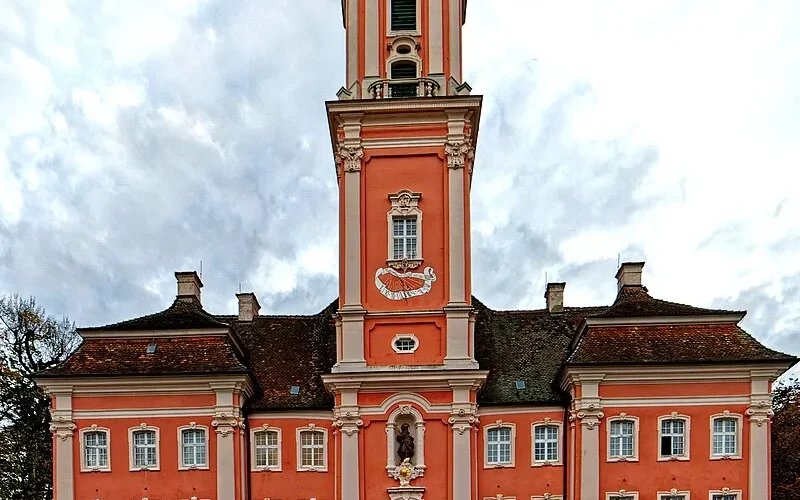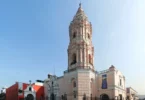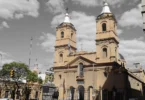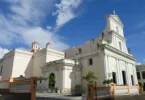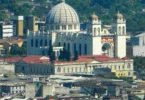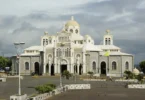Introduction

The Birnau pilgrimage church is a baroque church under the patronage of Mary ( Ascension, August 15th and Visitation, July 2nd ) on the northern shore of Lake Constance , between the towns of Nussdorf and Uhldingen-Mühlhofen in Baden-Württemberg . The church is located in Birnau on the western route of the Upper Swabian Baroque Road, directly on the B 31. It was built between 1746 and 1749 by the Vorarlberg master builder Peter Thumb for the Imperial Abbey of Salem . The church was given a rich baroque interior with frescoes by Gottfried Bernhard Götz as well as stucco work , altars and sculptures by Joseph Anton Feuchtmayer , the most famous of which is the Honey Licker , a putto with a beehive . The religious building in front of the church with its striking bell tower now houses a priory of the Cistercian Abbey of Wettingen-Mehrerau . Since 1946 it has also been the parish church of the towns of Deisendorf and Nußdorf.
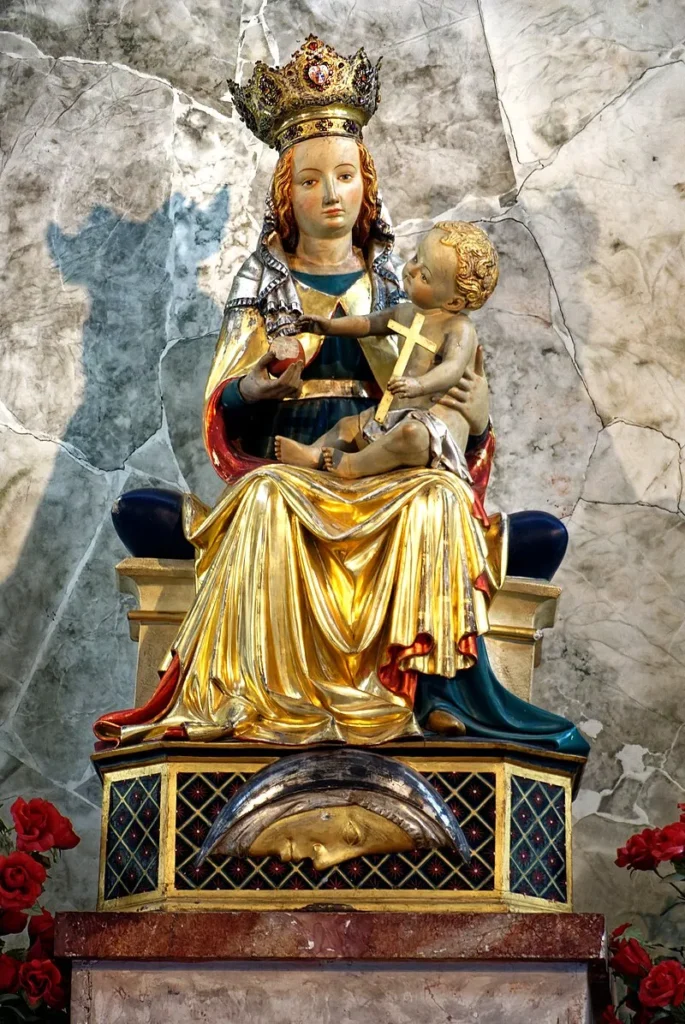
The Construction of the new church meant a serious disruption to the Marian pilgrimage. The stream of pilgrims was nowhere near as strong as in the old Birnau times. The spirit of enlightenment may have contributed to this; however, the relationship between the pious population and Birnau was also permanently damaged by the relocation of the shrine, against which even the council of the imperial city of Überlingen had protested. In addition, the state and the official church increasingly tried to prevent pilgrimages.
Closure Of The Church In 1804
A few decades after the new church was built, the Salem monastery faced closure under the influence of Ignaz von Wessenberg, the vicar general of the diocese of Constance and a supporter of Josephinism. Wessenberg, like many enlightened clerics, sought to close pilgrimage churches and convert them into parish churches, seeing the powerful religious orders and the veneration of images as superstitious and a challenge to the authority of the established church. This ideological shift coincided with the state’s secularization policies, and on October 1, 1802, a commission from Margrave Karl Friedrich arrived at Salem Abbey to announce the confiscation of its property, with the Imperial Deputation Act of 1803 making the closure of monasteries across the empire legally binding. By November 23, 1804, the Imperial Abbey of Salem was dissolved, and from then until 1918, no men’s orders were permitted under state control. The last service at Neubirnau took place in 1804, and by 1808, the church was closed, with its miraculous image moved to the Salem Minster, now a parish church. The church’s inventory was dispersed to surrounding churches, and its bells and organ were sold to Switzerland. Over the next century, the church stood empty, falling into disrepair, with parts like the roof turret and sacristy demolished. Meanwhile, the Rococo style, once admired, was deemed outdated as simpler styles like Classicism, Romanesque, and Gothic became popular, and Baroque architecture, including Rococo, was criticized for its excess and “degenerating” aesthetics. It wasn’t until the late 19th century that Baroque art began to regain acceptance, thanks to scholars like Heinrich Wölfflin. Birnau, however, marked the end of an era in church architecture, dubbed the “swan song of the Rococo on Lake Constance.” In the 19th century, bourgeois landscape painters rediscovered Birnau as a picturesque structure harmonizing with the natural beauty of Lake Constance, serving as a visual counterpoint to the onset of industrialization.
At the turn of the 20th century, efforts to reopen the church to believers gained momentum, with both the assessment of the Rococo style and the acceptance of pilgrimages having shifted significantly. In 1919, the Cistercian Abbey of Wettingen-Mehrerau acquired Birnau from the state of Baden for 70,000 marks, along with Maurach Castle, situated below the church on the lake. The church was restored and reopened, becoming a major religious and art-historical pilgrimage site on Lake Constance. During National Socialism, the church and priory were closed from 1941 to 1945, with monks being persecuted by the Gestapo. After the war, the monks returned, and in 1946, Birnau became the parish church for Deisendorf and Nußdorf. The nearby Birnau concentration camp cemetery, housing 97 prisoners who had died while working on a tunnel system for armaments factories, remains a somber reminder of the church’s wartime history. From 1964 to 1969, the church underwent significant renovation, and further extensive work took place in 1996, preserving its historical integrity. In 1971, Birnau was elevated to a minor basilica by Pope Paul VI. Today, it is one of the most popular pilgrimage destinations on Lake Constance, attracting tens of thousands of pilgrims annually, particularly for the Fatima pilgrimage. The church also hosts concerts and is a popular venue for weddings, celebrated for its picturesque location.
Building History
The Construction of a new pilgrimage church and the relocation of the miraculous image required secret approval from Pope Benedict XIV, granted through a papal bull on March 12, 1746, for fear of public backlash. Shortly after, on May 2, 1746, Abbot Stephan died at the age of 45, which some saw as divine retribution for the “kidnapping” of the image, but under the new abbot, Anselm II Schwab, the work continued with determination. The renowned Vorarlberg architect Peter Thumb was appointed to the planning committee, and after several designs, a compromise was reached. Construction began in 1747, with the foundation stone laid on June 11. The church was strategically located on a hilltop above Lake Überlingen, designed to tower over the lake like a connection between heaven and earth, and the surrounding area was kept undeveloped to preserve the long-distance effect, even at the cost of not orienting the altar to the east. The construction, which cost 150,000 guilders, was completed in under four years, with the church consecrated between September 19 and 24, 1750. Abbot Anselm delivered the consecration sermon, highlighting the iconography that linked the monastery to Mary and divine grace, while notable preachers like Sebastian Sailer and Joseph Vogelmayer explained the church’s artistic motifs. The new church also served as a show of power towards the imperial city of Überlingen, which had long sought to control the monastery. While the church’s construction successfully asserted the monastery’s authority, the strained relationship with Überlingen persisted until an official reconciliation in 1790.
Architecture of the Basílica de Birnau, Uhldingen-Mühlhofen, Germany
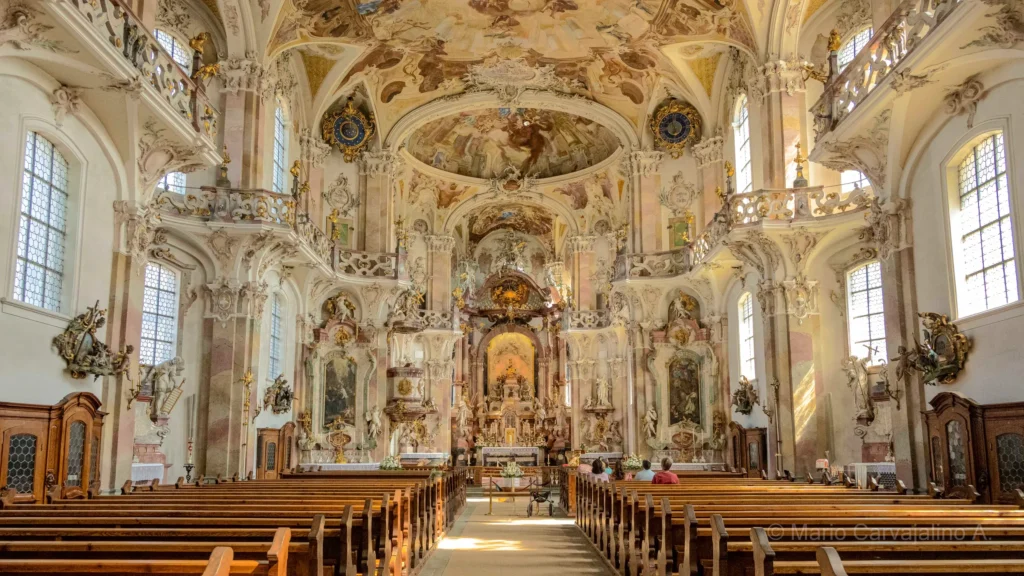
Architectural style: Baroque architecture
The church is designed as a hall church with a long nave and a transverse bar in front that houses the living and administrative rooms of the order, now also a souvenir shop. This space serves both as a physical and symbolic mediator between the surroundings and the pilgrimage church. The order’s building forms the church’s front, with two side projections reminiscent of the Salem monastery complex. Originally, the structure was planned to be much wider, resembling a feudal residence, and an open staircase leading from the lakeshore to the church forecourt was also envisioned. However, the monks avoided excessive courtly grandeur, even choosing to dispense with the usual east-west orientation of the nave to ensure the façade’s prominence from the lake.
The facade, visible from the lake, stretches over eleven window axes, divided by three pairs of Ionic colossal pilasters. The central pair frames the entrance portal and is crowned by a three-tiered bell tower, which makes Birnau visible from afar. While the tower was not initially part of the Cistercian architectural style, it was added to align with the order’s regulations by being separated from the church. The pilaster structure continues along the nave’s outer walls, and the original color scheme of white and old pink is preserved. The top of the tower features the abbot’s double cross.
Inside, the church features a hall-like design with no side aisles, a departure from the traditional Vorarlberg Minster scheme. Instead of side chapels and galleries, Thumb and his colleague Johann Georg Specht focused on a simpler design that allowed more space for artwork and sculpture. The nave is divided into three sections, tapering toward the altar. A continuous ambulatory runs halfway up the church, connecting to the organ gallery, while two side altars are placed in arched projections. The ceiling above the nave is a hollow vault, leading into a narrower, square choir with a flat dome. To the right of the choir is the pulpit, and behind it, the apse, which encloses the canopy altar by Feuchtmayer. The organ sits above the main entrance, with a simple gallery running around the room and dividing it at halfway height. Two rows of windows on each side light the interior, while the choir features separate window bays.
Interior
The interior of Birnau, designed in the ornamental Rococo style, creates a profound impact on viewers, with the grandeur of the church intentionally aimed at highlighting the greatness of God. The church’s design brings heaven and the afterlife to life, making them not just something to feel but something to see vividly, reflecting the Catholic Counter-Reformation’s use of art and architecture to draw believers back to the true faith. Abbot Anselm II, in his consecration sermon, emphasized that it was Mary herself who had built the church, with the intricate veneration of the Virgin ensuring the monastery’s divine support. The interior’s aesthetic model draws from Roman Baroque churches, where architectural elements like Andrea Pozzo’s illusionistic ceiling frescoes set the standard across Europe. In Birnau, the architecture, trompe-l’œil painting, and rocaille stucco were created simultaneously, in close collaboration, forming an artistic unity. The architectural elements flow into decorative forms, and the sculptural stucco extends into the false architecture of the ceiling paintings. Notably, the round ceiling fresco in the choir is set apart from the surrounding architecture, a style shift toward the simplicity of classicism. The use of simulated marble, achieved with stucco marble, offers consistent coloring and effect, helping to disguise the simple floor plan. The choir and altar area, designed with wide basket arches, resembles a proscenium stage, reinforcing the theatrical nature of Baroque Catholic liturgy, which often involved performances akin to Jesuit theater. This stage-like structure emphasized the high altar and statue of Mary at the center of both the performance and the space. For the church’s consecration in 1750, a melodramatic religious play was staged, symbolizing the transfer of the Ark of the Covenant to Jerusalem, alluding to the relocation of the Marian shrine to Birnau and the establishment of a new religious center.
Image Program
The Marian pictorial program in Birnau, created by the painter Gottfried Bernhard Göz, centers on the miraculous figure of the Virgin Mary and was designed to communicate complex theological themes to a learned audience. Commissioned through a competition by Salem Abbey, the program’s content was carefully defined by the monastery, with many depictions meant to convey deep theological connections, some of which remain ambiguous and open to interpretation. The iconography of Mary begins with the miraculous statue on the altar and continues throughout the church, particularly in the ceiling frescoes. The recurring use of bright blue ties the Marian depictions together visually. The series of images begins (or once began) with the missing Assumption of Mary, and other Marian motifs are repeated in the choir and nave, guiding the viewer’s attention toward the altar and encouraging contemplation of their connections. Another key focus of the program is the Cistercian order’s identity and traditions, linking Mary to the founders and patron saints of the order. A significant portion of the frescoes celebrates the builders of Birnau, positioning the church as a gift to the Virgin Mary and affirming Salem Abbey’s deep spiritual connection to the Mother of God.
Ceiling Fresco Of The Apse
Above the altar, in the vaulted ceiling of the apse, a scene from the Book of Esther is depicted: Esther asks King Ahasuerus for mercy for her people. The scene is depicted from a dramatic low angle, so that the canopy above Ahasuerus’ head appears like a second altar canopy framed by a false entablature.
A little above is a depiction of Christ about to hurl arrows of punishment at humanity. The latter is represented by a half-naked female figure, presumably a depiction of Luxuria . Mary kneels to the left below the angry Son of God and intercedes for humanity. The scene refers to a vision of the monk William of Clairvaux in which Mary asks Christ to spare humanity, if not for its own sake, then at least for the sake of the Cistercians. Esther must therefore be understood as a typological prefiguration of Mary: while Esther saves the Jewish people, Mary asks for mercy for all of humanity. Mary and Esther adopt the same posture in both depictions, so that they are also formally related to each other.
Ceiling Fresco Of The Choir
The fresco above the choir in Birnau creates the illusion of a deep, coffered dome, with Mary ascending into the church surrounded by angels, inspired by Andrea Pozzo’s famous dome painting in Rome’s Sant’Ignazio. Unlike Pozzo’s temporary solution for a faulty dome, Birnau’s vault was intentionally designed to be flat, enhancing the impact of the illusionistic painting. In this fresco, Mary is depicted as the “Woman of the Apocalypse,” crushing the serpent of original sin with her foot, while also portraying the “pregnant Mary” with the Christ child visible in front of her. A ray of light, symbolizing God’s grace, emanates from the child onto a Sacred Heart held by an allegorical figure representing divine love (Caritas). The grace is then directed onto a mirror held by a putto, symbolizing wisdom and the immaculate conception, but also reflecting the real space of the church. This clever use of a real mirror connects the illusionary scene with the actual church space, inviting believers to feel the grace of Christ’s love. Surrounding Mary are four virtues—Hope, Fear of God, Knowledge of God, and Faith—each personified by a female figure with appropriate symbols. The figures are paired with a biblical quote from Sirach, which was used in the church’s consecration sermon, emphasizing Mary’s role as the mother of love, fear, knowledge, and hope.
Ceiling Fresco Of The Nave
The Ceiling Fresco in Birnau is a stunning blend of sacred and secular imagery, designed to convey both theological messages and the church’s pilgrimage function. The fresco is divided into two parts by a light-colored stucco band: the western half depicts a concert of angels, harmonizing with the organ music, while the eastern half centers on an image of the Virgin Mary, modeled on the miraculous statue on the altar, with an eight-pointed star above her head symbolizing both the Messiah and Mary as the “morning star.” Surrounding her are secular figures, including pilgrims, the poor, and the sick, among them an image of the artist Gottfried Bernhard Göz, who humorously depicts himself as a reclining figure with a bandaged leg after a fall from the scaffolding. The pilgrims represent the church’s function as a pilgrimage site, yet Mary faces the donors and planners instead, highlighting their contribution to the church. On her left stand Guntram von Adelsreuthe and his daughter Mathilde, key founders of Salem Monastery, while on the right, the initiators of the church’s construction—Stephan II Enroth, Anselm Schwab, and Konstantin Miller—present a drawing of the church to Mary. Above them, Cistercian abbots depict a bird’s-eye view of Salem Monastery, juxtaposed with a representation of heavenly Jerusalem on the opposite side. This typological correspondence, referencing the connection between Salem and Jerusalem, is emphasized by three banners held by angels, displaying the biblical verse from Judith 15:9, “You are the glory of Jerusalem, the great joy of Israel, and the pride of our people,” drawing a parallel between Mary and the Old Testament figure Judith, as well as between the monastery and the heavenly city.
Miraculous Image
The wooden statue of the Virgin Mary, now the focal point of Birnau’s visual program, dates back to around 1420 and was created by an unknown master in the Salzkammergut region. This late Gothic seated Madonna, crowned and sitting on a padded pedestal, holds the Christ Child on her lap, who in turn holds a crucifix. The crescent moon beneath her throne references the Book of Revelation, while the apple in her right hand symbolizes original sin and mankind’s need to overcome evil to reach God. Despite being restored and repainted multiple times, including the crown’s reworking in 1733, the statue became known as the “image of grace” and was considered miraculous, attracting pilgrims. However, its relocation in 1745 sparked controversy, as many believed its power was tied to its original location. Fearing resistance from the citizens of Überlingen, who benefitted from the pilgrimage, the monastery secretly secured permission from the Prince-Bishop of Constance and transported the statue to its temporary home in the parish church of St. Leonhard in Salem on March 4, 1746, under heavy protection. After being checked for authenticity, the statue was brought to its new home in the newly consecrated Birnau church during a grand procession on September 20, 1750, where it was placed above the high altar, marking its permanent relocation.
Organs
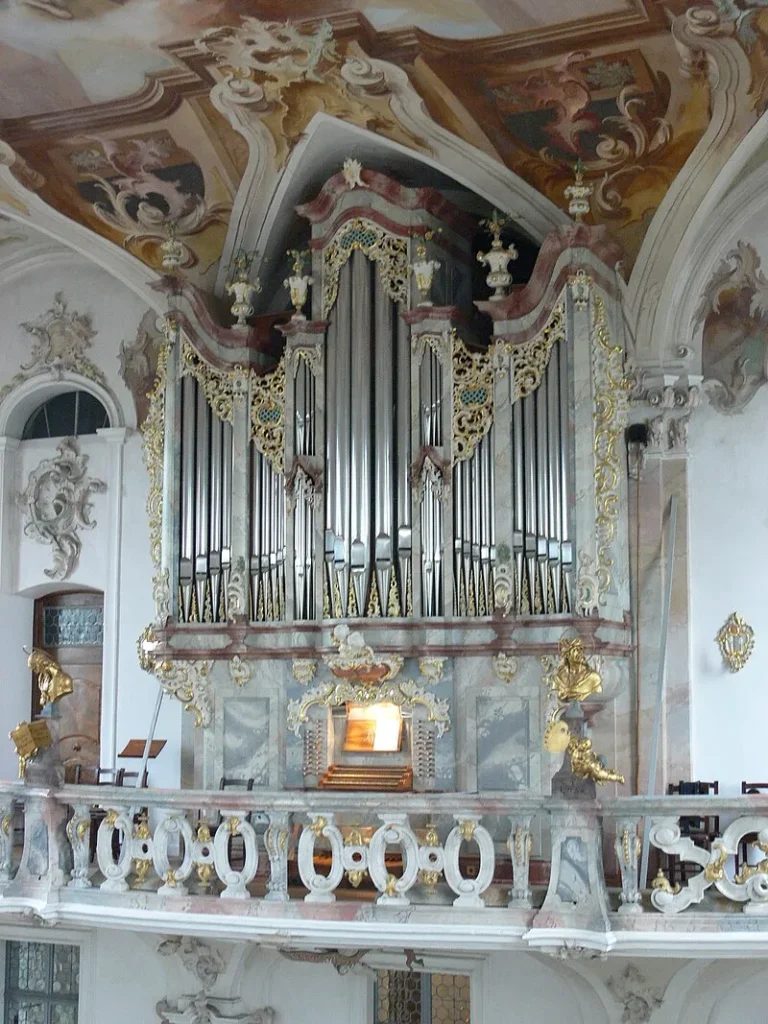
The first organ in Birnau was built by Johann Georg Aichgasser from Überlingen. It had only one manual and twelve registers . In 1808 it was sold to the Reformed Church in Altnau ( Canton Thurgau ). Although the organ no longer exists there, the carved facade has been preserved.
In 1950, a new organ was purchased for Birnau, which was also built by an organ builder in Überlingen. The current, third organ was built in 1991 with a purely mechanical action by Mönch Orgelbau (Überlingen). The instrument has 39 registers and 2644 pipes. They are distributed over three manuals and a pedal.
Feast Day
Feast day: 8 September
Feast day. Marymas is traditionally celebrated as a liturgical feast on 8 September, nine months after the solemnity of the Immaculate Conception, celebrated on 8 December, according to the General Roman Calendar, many Lutheran calendars, most Anglican calendars, and the Tridentine calendar.
Church Mass Timing
Monday : 8.00 am.
Tuesday : 8.00 am.
Wednesday : 8.00 am.
Thursday : 8.00 am.
Friday : 8.00 am.
Saturday : 8.00 am.
Sunday :7.30 am., 9:00 am., 10.45 am.
Church Opening Time:
Monday : 9:00 am – 5:00 pm
Tuesday : 9:00 am – 5:00 pm
Wednesday : 9:00 am – 5:00 pm
Thursday : 9:00 am – 7:00 pm
Friday : 9:00 am – 5:00 pm
Saturday : 9:00 am – 5:00 pm
Sunday : 9:00 am – 5:00 pm
Contact Info
Address :
Birnau pilgrimage church
Birnau-Maurach 5, 88690 Uhldingen-Mühlhofen, Germany.
Phone: +49 7556 92030
Accommodations
Connectivities
Airway
Friedrichshafen Airport to the Basílica de Birnau, Uhldingen-Mühlhofen, “Germany distance between 33 min (30.7 km) via B31.
Railway
Uhldingen-Mühlhofen station to the Church of Basílica de Birnau, Uhldingen-Mühlhofen, Germany distance between 5 min (3.0 km) via B31.

